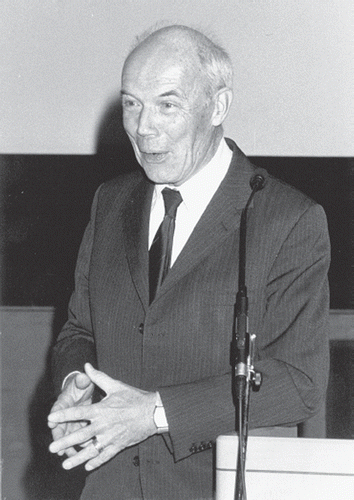Lars-Gunnar Larsson, the first chief-editor of Acta Oncologica , died on October 12th, 2009. Lars-Gun-nar Larsson was born in Katrineholm, Sweden in 1919. He completed his medical studies in 1946 and began that year to work at Radiumhemmet in Stockholm, where he remained until 1959. He was there-after appointed the first professor of radiotherapy at the hospital in Umeå, Sweden. Under his leadership, a new and modern department of radiotherapy was planned and built. It stood ready for use in 1962. He was head of the department until 1976.
When the high school in Umeå acquired university status in 1965, he was appointed the first rector of the university. He utilized great energy to build up the administration, all the faculties and planned the new buildings.
During the early 1970s, the speciality of oncology developed markedly. Lars-Gunnar Larsson, together with the late Jerzy Einhorn, led an investigation that resulted in the name of the speciality being changed from radiotherapy to oncology. In this investigation, completed in 1974, it was suggested that the care of cancer patients be organized according to existing health service structures, a situation that differed from that existing in many other countries. The functional co-ordination of cancer care was thus organized in the six health-care regions. In 1976, Lars-Gunnar Larsson became the first head of the Oncological Centre in the Umeå Health-Care Region. This organization, further emphasized in a review of 1991, still exists.
In 2009, a new governmental investigation has suggested the creation of regional cancer centres (RCCs) with slightly expanded duties compared with those of the regional oncology centres (ROCs). The number of centres has also been questioned. Whether the RCCs are only a new name for an old concept or will mean a substantial change and a new step-forward still remains to be seen. At any rate, the ideas and structures based upon an investigation performed 45 years ago and led by Lars-Gunnar Larsson have created possibilities for Sweden to be a leading country in the care of cancer patients.
Lars-Gunnar Larsson retired in 1984 but continued his activities until the very last period of his life.
Radioactive iodine was introduced for the diagnosis and treatment of thyrotoxicosis and thyroid cancers in the mid 1940s. The first patient was diagnosed and treated in Sweden in 1950. Radiumhemmet made a very significant contribution to this development, especially under the leadership of Lars-Gunnar Larsson, who became the head of the clinical radio-iodine unit at the hospital. Articles on the first three cases of thyroid cancer treated with radio-iodine in Sweden were published in 1953. Lars-Gunnar Larsson presented his thesis on “Studies on radioiodine treatment of thyrotoxicosis with special reference to the behavior of the radio-iodine tracer tests” in 1955. His interest in these cancers continued throughout his life. In 2005, Lars-Gunnar Larsson organized an international meeting in Umeå that celebrated developments in the use of radioactive iodine in medicine. Articles from the meeting were published in Acta Oncologica the following year and included an update of several of the first thyroid cancers treated by him in the early days. The publication describes several successfully treated extremely advanced cases. We hardly see such cases today.
Acta Oncologica took off in 1987, officially as a continuation of the old oncology series of Acta Radiologica but, in reality, as a new, independent journal. Acta Radiologica was founded back in 1921. In 1963, it added the post-fix “Therapy, physics, biology”, which were altered in 1978 to “Oncology, radiation, physics, biology” and, in 1980, to purely and simply “Oncology”. Lars-Gunnar Larsson became, in 1984, the editor of Acta Radiologica Oncology , in 1986 its chief-editor, and continued as chief-editor for Acta Oncologica from its foundation in 1987 to 1995, when the late Jerzy Einhorn became chief-editor. Both Lars-Gunnar Larsson and Jerzy Einhorn were instrumental in the splitting of Acta Radio-logica , reflecting the growing clinical speciality and its concomitant research area. Under their leadership, the journal developed continuously as an important scientific periodical with its base in the Nordic countries. After his retirement as chief-editor, Lars-Gunnar Larsson continued as a knowledgeable and engaged member of the board of the Acta Oncologica Foundation until his death. As a board member, he was of great help in all efforts made to continuously improve the journal and increase its attractiveness. At an early point he vigorously criticized the journal impact factor (JIF) as a quality parameter implemented for scientific periodicals. He, however, realized the relevance JIF possessed for attracting authors to submit their manuscripts to a particular journal.
Lars-Gunnar Larsson was a remarkable person who forged breakthroughs into many new areas. He had a strong will and an enormous work capacity. At the same time, he was a very kind and open person, who created a friendly climate that could develop under his leadership.
Many have witnessed his great strengths that made him an important leader, not, least in the development of radiotherapy into an oncology discipline. It has been a great experience and pleasure to work with him and after him.
